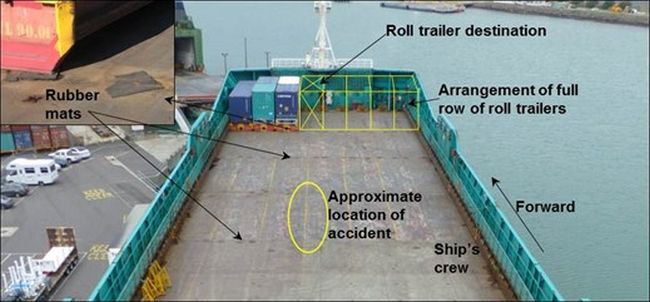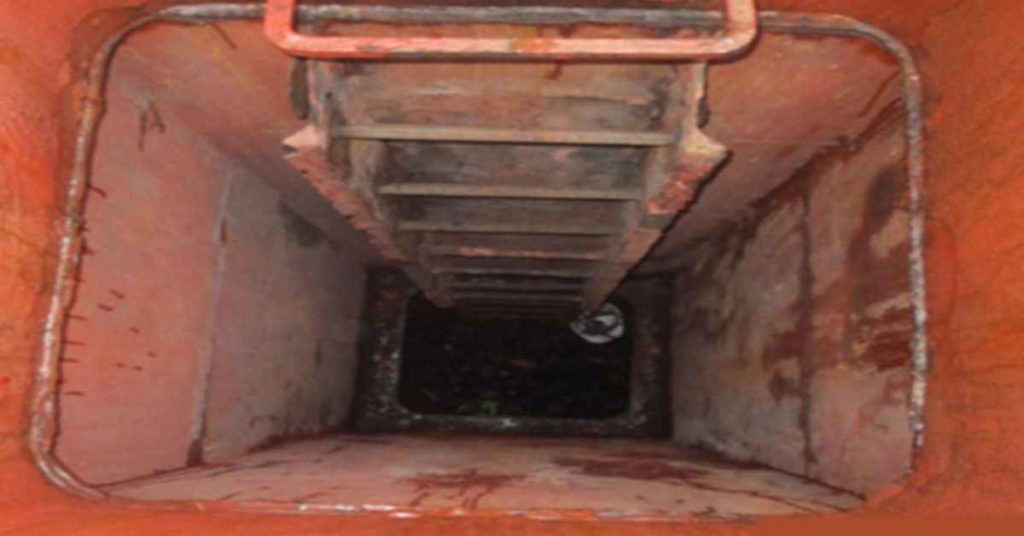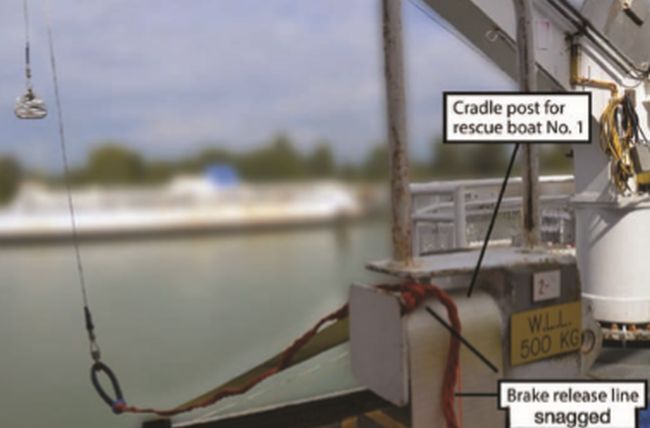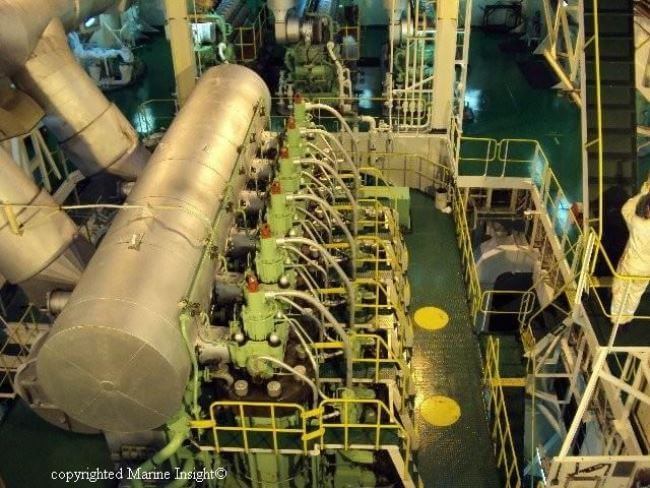Enclosed Lifeboat Release Accidents: Reasons And Prevention
I have been sailing in ships with enclosed lifeboats that have the hook-release mechanism with hydrostatic interlocks for the last 10 years. I have never come across any officer who under stood this simple mechanism properly. I fail to understand why. As a matter of practice, I never allow my third officers or chief officers to do anything concerned with the release mechanism without my prior approval (in fact I do the required maintenance or inspection myself and take them with me to explain the system to them).
On my present vessel, I had opened the panel covering the hydrostatic interlock inside the port-side boat in order to explain the system to my cadet and an officer when I found that something was wrong in the whole interlock system, as the hydrostatic interlock did not seem to be doing any interlocking work. After a few minutes trying to figure this out without much success, I opened the panel of the starboard boat. I discovered that the interlock was working well in this boat but there was something wrong with the port boat. On further investigation, I realized that the boat hooks were not engaged properly, hence the hydrostatic interlock was not interlocking as it should be. I further noticed that the cam of the hook release mechanism could be seen very clearly and that it was not vertical as it should be but was slightly tilted.
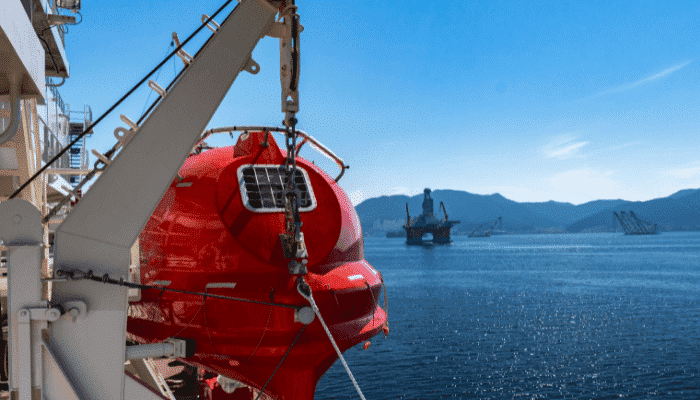
If the boat had been lowered into the water with the crew in it, with the hooks in this incorrect position, there would most probably be an accident resulting in death or injury, such as those we all have read about many times in various circulars.
Throughout my career I have come across MARS reports, circulars from flag state, P & I clubs and class, MAIB reports etc about lifeboat drill accidents. According to an MAIB report, 12 seafarers were killed and 87 injured between 1991 and 2001 while involved in lifeboat drills or testing – which represented more than 15 per cent of the total number of seafarers killed in all accidents during the period.
These circulars more than mention the causes of these accidents; however circulars and other mariners (including ourselves) have not gone to greater lengths to try to come up with some way of sorting these out. According to my understanding from these circulars etc, the main reason for such accidents is incorrect engaging of the hook-release mechanism after lowering and maneuvering the boats in the water and lack of understanding of the hydrostatic interlock.
The reasons for this include:
1. Not understanding the mechanism (as mentioned earlier).
2. The instruction plates inside lifeboats are incorrectly written (l have recently been in Chinese-built ships). For example, the instruction plate inside the lifeboat of my current vessel says for the hydrostatic interlock; ‘in emergency break glass and pull this pin’ (interlock over ride). When I was in the boat with my officer, I asked him what was the meaning of emergency with respect to this? Obviously, he could not answer this satisfactorily. in this case, anyone not conversant with the system will think that the ’emergency’ means that when it is necessary to abandon the vessel, they will go ahead and break the glass and pull out the hydrostatic interlock pin and thereby remove this safety device. If the boat is disengaged by mistake from a substantial height, injuries or deaths are bound to occur while abandoning the vessel.
3. It is very difficult in most boats physically to see that the hooks are engaged properly. We usually do it by trying to move the hooks from their engaged position and confirm that there is no play (although some boats have indicators near the hooks to show that they are engaged properly. I have also come across boats which have indicators near the hydrostatic interlock to show that the boat is waterborne and hence it’s safe to release the boats).
4. For the first time in my career in my current vessel, I have come across a boat in which the cam can be clearly seen (the cam area is not usually visible as it is obstructed by the cheek-plates of the hook foundation). If all the boats are designed like ours, I am sure it would reduce accidents, This can only be forced on the boat manufacturer by making it a class/Solas
requirement.
5. The lifeboat manuals are never clear (or the wording is too complicated) about the re-engagement procedure for this mechanism. For example, in my present vessel, the following are among the procedures mentioned to confirm that hooks are engaged properly – but these are wrong.
i) Check tell-tale indicators on/near hooks – they are not there.
ii) Check tell-tales marking on cables below the book – also not there.
iii) It says that it can be very difficult to see clearly that both the hooks appear to be locked (also wrong as in this boat we can clearly see the cam). Please note that this manual has been prepared by a classification society on behalf of the shipyard. Also please note that the manual does not mention that we can and must check the flat portion of the cam visually (which can be clearly seen in this boat) and confirm that it is vertical.
Recommendation for reducing these accidents:
a. During the course of proficiency in survival craft, everybody must be shown a demonstration model of the mechanism; also during the evaluation test of the same course, everybody must show proficiency in understanding this system. Everybody must be asked about this mechanism in orals for all deck/engineer certificates.
b. Make the arrangement of hooks such that the cam is visible, as mentioned earlier.
c. The panel cover plate in the lifeboat, which covers the area of the hydrostatic interlock, should be made of a transparent/ clear material (please see my experience mentioned above for the reason for this).
d. The panel cover·plate which covers the area near the hook inside the lifeboat should also be made of clear material; and the required portion of the release wire/cable should have a red/green area which will clearly indicate that the wire is in correct position; and hence the cam should also be in correct position.
e. Manuals for lifeboats and the instruction plates put in lifeboats should be scrutinized thoroughly by the class surveyor before being approved. The class surveyor must read the portion of the manual pertaining to the releasing of the boat and the re-engagement of hooks particularly carefully.
f. During the load test of boats in dry dock, the boats must be tested by hanging them from the hooks, then by hanging them from the hanging off points via the maintenance shackles (these also must be load tested, if provided).
g. The hook release mechanism, hooks foundation, release mechanism wire/cable, surface wear of the hook tail area (where it meets the cam) and surface wear of the cam flat surface area should be thoroughly inspected by the class surveyor or an approved technician during the load test. I believe that the ship’s staff are not qualified for this, especially when they don’t even understand the system properly.
h. Boats should never be lowered/heaved up with the crew inside during drills (Solas regulation 19.3.3.3, luckily going to be amended from 01 July 2006). I allow some crew to be inside the boat (and properly secured) while lowering only if the boats are provided with maintenance shackles. Before lowering, we connect them to the falls floating-block assembly and when the boat is just above the water, stop lowering and remove the shackles before continuing to lower the boat into the water. The reverse procedure is followed while picking up the boat.
i. On every occasion before carrying out the boats lowering, the crew must be briefed about the release mechanism and the re-engaging procedure. They must also be debriefed every time after the drill regarding the same procedures.
j. AlI ships should be provided with a safety video made by the manufacturer of the particular release mechanism and passed by class. In this movie, the class surveyor should pay particular attention to the part explaining the hydrostatic interlock and the re-engaging procedure.
k. The class surveyor should not approve any system which is too complicated (as is the case with some systems).
Reference: nautinst.org
Do you have info to share with us ? Suggest a correction
About Author
Marine Insight News Network is a premier source for up-to-date, comprehensive, and insightful coverage of the maritime industry. Dedicated to offering the latest news, trends, and analyses in shipping, marine technology, regulations, and global maritime affairs, Marine Insight News Network prides itself on delivering accurate, engaging, and relevant information.

About Author
Marine Insight News Network is a premier source for up-to-date, comprehensive, and insightful coverage of the maritime industry. Dedicated to offering the latest news, trends, and analyses in shipping, marine technology, regulations, and global maritime affairs, Marine Insight News Network prides itself on delivering accurate, engaging, and relevant information.
- Real Life Incident: Vessel Collision in Good Visibility
- Real Life Incident: Severe Injury To Deck Crew While Leaving Berth
- Real Life Incident: Departure Damage in Very Restricted Waterway
- Real Life Incident: Low Situational Awareness Has High Impact Consequence
- Real Life Incident: Fouled Anchor in a Designated Anchorage
- Real Life Incident: Fire On Barge Carrying Scrap Metal Causes $7 Million Worth Of Damage
Latest Case studies Articles You Would Like:
Subscribe To Our Newsletters
By subscribing, you agree to our Privacy Policy and may receive occasional deal communications; you can unsubscribe anytime.










